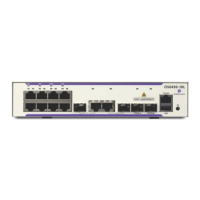Configuring BFD Configuring BFD
page 16-20 OmniSwitch AOS Release 7 Network Configuration Guide March 2011
BFD status for VRRP protocol is now enabled which means that socket communication between VRRP
and BFD is enabled. To de-register VRRP with BFD, enter the following command at the system prompt:
-> vrrp bfd-state disable
To verify the BFD status for VRRP protocol, you can use the show vrrp command as shown below:
-> show vrrp
VRRP default advertisement interval: 1 second
VRRP default priority: 100
VRRP default preempt: Yes
VRRP trap generation: Enabled
VRRP startup delay: 45 (expired)
VRRP BFD-STATUS : Enabled
IP Admin Adv.
VRID VLAN Address(es) Status Priority Preempt Interval
----+ ----+ -------------+----------+----------+----------+---------
1 1 192.168.170.1 Enabled 255 Yes 1
192.168.170.2
2 15 10.2.25.254 Disabled 100 No 1
2 Once VRRP is registered with BFD at the protocol level, enable BFD for a particular VRRP track
policy using the vrrp track address bfd-state command. Ensure that the track policy is associated with at
least one of the virtual routers. For example:
-> vrrp track 2 address 10.1.1.1 bfd-state enable
The above command enables BFD for a track policy with VRRP track number 2 and a remote interface
address of 10.1.1.1.
Note. The value of the address parameter should be a remote interface address. BFD cannot be configured
for a local interface address.
Use the show vrrp track command to verify whether BFD is enabled for a particular track policy. For
example:
-> show vrrp track
Track Admin Oper BFD
ID Policy State State Pri Status
-----+---------------------------------------+----------+------+------+---------
1 190.1.1.10 Enabled Down 100 Disabled
2 10.1.1.1 Enabled Up 25 Enabled
Use the show ip bfd interfaces command to verify the BFD interface/session configuration and operation
status.
Once the track policy is configured, the BFD session is established with the remote IP address. BFD
session is also established with the BFD neighbors.

